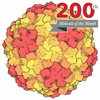[English] 日本語
 Yorodumi
Yorodumi- PDB-9eab: Seneca valley virus Altered particle at physiological condition (... -
+ Open data
Open data
- Basic information
Basic information
| Entry | Database: PDB / ID: 9eab | ||||||
|---|---|---|---|---|---|---|---|
| Title | Seneca valley virus Altered particle at physiological condition (A-particle[P]) | ||||||
 Components Components |
| ||||||
 Keywords Keywords | VIRUS / SVV / Capsid / Physiological condition / Non-enterovirus / A-particle / Altered particle / genome release / capsid uncoating / Seneca Valley virus / Senecavirus / Oncolytic virus | ||||||
| Function / homology |  Function and homology information Function and homology informationsymbiont-mediated suppression of host cytoplasmic pattern recognition receptor signaling pathway via inhibition of IRF7 activity / host cell nucleolus / adhesion receptor-mediated virion attachment to host cell / symbiont-mediated suppression of host TRAF-mediated signal transduction / symbiont-mediated suppression of host cytoplasmic pattern recognition receptor signaling pathway via inhibition of RIG-I activity / symbiont-mediated suppression of host cytoplasmic pattern recognition receptor signaling pathway via inhibition of MAVS activity / picornain 3C / T=pseudo3 icosahedral viral capsid / host cell cytoplasmic vesicle membrane / channel activity ...symbiont-mediated suppression of host cytoplasmic pattern recognition receptor signaling pathway via inhibition of IRF7 activity / host cell nucleolus / adhesion receptor-mediated virion attachment to host cell / symbiont-mediated suppression of host TRAF-mediated signal transduction / symbiont-mediated suppression of host cytoplasmic pattern recognition receptor signaling pathway via inhibition of RIG-I activity / symbiont-mediated suppression of host cytoplasmic pattern recognition receptor signaling pathway via inhibition of MAVS activity / picornain 3C / T=pseudo3 icosahedral viral capsid / host cell cytoplasmic vesicle membrane / channel activity / symbiont-mediated suppression of host cytoplasmic pattern recognition receptor signaling pathway via inhibition of TBK1 activity / monoatomic ion transmembrane transport / symbiont-mediated suppression of host toll-like receptor signaling pathway / symbiont-mediated suppression of host cytoplasmic pattern recognition receptor signaling pathway via inhibition of IRF3 activity / ubiquitinyl hydrolase 1 / entry receptor-mediated virion attachment to host cell / cysteine-type deubiquitinase activity / RNA helicase activity / RNA helicase / RNA-directed RNA polymerase / cysteine-type endopeptidase activity / viral RNA genome replication / RNA-directed RNA polymerase activity / DNA-templated transcription / symbiont entry into host cell / structural molecule activity / ATP hydrolysis activity / proteolysis / RNA binding / ATP binding / membrane Similarity search - Function | ||||||
| Biological species |  Seneca Valley virus USA/SSV-001 Seneca Valley virus USA/SSV-001 | ||||||
| Method | ELECTRON MICROSCOPY / single particle reconstruction / cryo EM / Resolution: 3.39 Å | ||||||
 Authors Authors | Kumaran, R. / Bostina, M. | ||||||
| Funding support | 1items
| ||||||
 Citation Citation |  Journal: J Virol / Year: 2025 Journal: J Virol / Year: 2025Title: Cryo-EM structure of the Seneca Valley virus A-particle and related structural states. Authors: Rosheny Kumaran / Nadishka Jayawardena / Kuan-Lin Chen / Alice-Roza Eruera / James Hodgkinson-Bean / Laura N Burga / Matthias Wolf / Mihnea Bostina /   Abstract: Picornavirus cell entry requires a series of capsid protein conformational changes leading to genome uncoating. For enteroviruses, receptor binding triggers the transition from a full (F) capsid to ...Picornavirus cell entry requires a series of capsid protein conformational changes leading to genome uncoating. For enteroviruses, receptor binding triggers the transition from a full (F) capsid to an altered (A) particle before releasing its genome and finally converting it into an empty (E) particle. In contrast, non-enteroviruses, such as Aphthovirus, Cardiovirus, or Seneca Valley virus, release their genomes by dissociating the capsid into pentamers. While the existence of a transient A-particle for non-enteroviruses was previously speculated, it has never been directly observed using structural methods. Seneca Valley virus (SVV) is an oncolytic picornavirus that selectively targets cancer cells by recognizing Tumor endothelial marker 8 (TEM8) as the host receptor. SVV disassembles into pentamers at acidic pH, suggesting that the acidic environment of the endosome could cause capsid disassembly. We used cryo-electron microscopy to investigate SVV under acidic conditions and in complex with TEM8 at physiological pH, identifying multiple uncoating intermediates. These include an altered-particle, an empty-rotated particle (E), and a series of open particles expelling the coiled genome. The A-particle is expanded, displays reduced interactions between capsid proteins, a reorganized genome, and has a poorly resolved VP1 N-terminus, VP2 N-terminus, and VP4. The E particle has rotated pentamers, reduced contacts within the particle, lacks the genome, VP1 and VP2 N-termini, and VP4. Our work provides an understanding of transient SVV structural states and supports the existence of an intermediate SVV A-particle. These findings could help optimize SVV for oncolytic therapy.IMPORTANCESeneca Valley virus (SVV) is a non-enterovirus picornavirus with specific tumor tropism mediated by the receptor Tumor endothelial marker 8, also known as Anthrax toxin receptor 1. Using cryo-electron microscopy, it was possible to identify multiple structural states of SVV. We demonstrate that SVV capsids transition from full particles to altered (A) particles and then to empty-rotated (E) particles, with receptor binding and acidic pH driving these conformational changes, respectively. This study also identifies open particles with expelled genomes. Comparisons between A- and E-particles reveal that peptide segments of VP1, VP2, and VP4 could potentially play a role in genome delivery. Future work can explore the formation of these structural states . | ||||||
| History |
|
- Structure visualization
Structure visualization
| Structure viewer | Molecule:  Molmil Molmil Jmol/JSmol Jmol/JSmol |
|---|
- Downloads & links
Downloads & links
- Download
Download
| PDBx/mmCIF format |  9eab.cif.gz 9eab.cif.gz | 292.6 KB | Display |  PDBx/mmCIF format PDBx/mmCIF format |
|---|---|---|---|---|
| PDB format |  pdb9eab.ent.gz pdb9eab.ent.gz | 237.4 KB | Display |  PDB format PDB format |
| PDBx/mmJSON format |  9eab.json.gz 9eab.json.gz | Tree view |  PDBx/mmJSON format PDBx/mmJSON format | |
| Others |  Other downloads Other downloads |
-Validation report
| Arichive directory |  https://data.pdbj.org/pub/pdb/validation_reports/ea/9eab https://data.pdbj.org/pub/pdb/validation_reports/ea/9eab ftp://data.pdbj.org/pub/pdb/validation_reports/ea/9eab ftp://data.pdbj.org/pub/pdb/validation_reports/ea/9eab | HTTPS FTP |
|---|
-Related structure data
| Related structure data |  47828MC  9eaaC  9eacC  9eadC C: citing same article ( M: map data used to model this data |
|---|---|
| Similar structure data | Similarity search - Function & homology  F&H Search F&H Search |
- Links
Links
- Assembly
Assembly
| Deposited unit | 
|
|---|---|
| 1 | x 60
|
- Components
Components
| #1: Protein | Mass: 28459.969 Da / Num. of mol.: 1 / Source method: isolated from a natural source / Source: (natural)  Seneca Valley virus USA/SSV-001 / References: UniProt: Q155Z9 Seneca Valley virus USA/SSV-001 / References: UniProt: Q155Z9 |
|---|---|
| #2: Protein | Mass: 26353.938 Da / Num. of mol.: 1 / Source method: isolated from a natural source / Source: (natural)  Seneca Valley virus USA/SSV-001 / References: UniProt: Q155Z9 Seneca Valley virus USA/SSV-001 / References: UniProt: Q155Z9 |
| #3: Protein | Mass: 29755.227 Da / Num. of mol.: 1 / Source method: isolated from a natural source / Source: (natural)  Seneca Valley virus USA/SSV-001 / References: UniProt: Q155Z9 Seneca Valley virus USA/SSV-001 / References: UniProt: Q155Z9 |
| #4: Protein | Mass: 5998.467 Da / Num. of mol.: 1 / Fragment: UNP residues 93-150 / Source method: isolated from a natural source / Source: (natural)  Seneca Valley virus USA/SSV-001 / References: UniProt: Q155Z9 Seneca Valley virus USA/SSV-001 / References: UniProt: Q155Z9 |
| #5: Chemical | ChemComp-CA / |
| Has ligand of interest | Y |
| Has protein modification | N |
-Experimental details
-Experiment
| Experiment | Method: ELECTRON MICROSCOPY |
|---|---|
| EM experiment | Aggregation state: PARTICLE / 3D reconstruction method: single particle reconstruction |
- Sample preparation
Sample preparation
| Component | Name: Seneca Valley virus USA/SSV-001 / Type: VIRUS / Entity ID: #1-#4 / Source: NATURAL |
|---|---|
| Molecular weight | Experimental value: NO |
| Source (natural) | Organism:  Seneca Valley virus USA/SSV-001 Seneca Valley virus USA/SSV-001 |
| Details of virus | Empty: NO / Enveloped: NO / Isolate: STRAIN / Type: VIRION |
| Buffer solution | pH: 7 |
| Specimen | Conc.: 0.25 mg/ml / Embedding applied: NO / Shadowing applied: NO / Staining applied: NO / Vitrification applied: YES Details: SVV was incubated with TEM8 with a receptor ratio of 600 receptors per capsid. It was held at 37 degree Celsius for 90 minutes prior being vitrified for Cryo EM. |
| Specimen support | Grid type: Quantifoil Active R2/1 |
| Vitrification | Instrument: FEI VITROBOT MARK IV / Cryogen name: ETHANE / Humidity: 95 % / Chamber temperature: 310.15 K |
- Electron microscopy imaging
Electron microscopy imaging
| Experimental equipment |  Model: Titan Krios / Image courtesy: FEI Company |
|---|---|
| Microscopy | Model: TFS KRIOS |
| Electron gun | Electron source:  FIELD EMISSION GUN / Accelerating voltage: 300 kV / Illumination mode: SPOT SCAN FIELD EMISSION GUN / Accelerating voltage: 300 kV / Illumination mode: SPOT SCAN |
| Electron lens | Mode: OTHER / Nominal defocus max: 1500 nm / Nominal defocus min: 400 nm / Cs: 2.7 mm |
| Image recording | Electron dose: 40 e/Å2 / Film or detector model: FEI FALCON III (4k x 4k) |
- Processing
Processing
| EM software |
| ||||||||||||||||||||||||||||||||||||||||||||||||||
|---|---|---|---|---|---|---|---|---|---|---|---|---|---|---|---|---|---|---|---|---|---|---|---|---|---|---|---|---|---|---|---|---|---|---|---|---|---|---|---|---|---|---|---|---|---|---|---|---|---|---|---|
| CTF correction | Type: PHASE FLIPPING AND AMPLITUDE CORRECTION | ||||||||||||||||||||||||||||||||||||||||||||||||||
| Symmetry | Point symmetry: I (icosahedral) | ||||||||||||||||||||||||||||||||||||||||||||||||||
| 3D reconstruction | Resolution: 3.39 Å / Resolution method: FSC 0.143 CUT-OFF / Num. of particles: 858 / Symmetry type: POINT | ||||||||||||||||||||||||||||||||||||||||||||||||||
| Atomic model building | Protocol: AB INITIO MODEL | ||||||||||||||||||||||||||||||||||||||||||||||||||
| Atomic model building | 3D fitting-ID: 1 / Accession code: 3cji / Initial refinement model-ID: 1 / PDB-ID: 3cji / Source name: PDB / Type: experimental model
| ||||||||||||||||||||||||||||||||||||||||||||||||||
| Refinement | Highest resolution: 3.39 Å Stereochemistry target values: REAL-SPACE (WEIGHTED MAP SUM AT ATOM CENTERS) | ||||||||||||||||||||||||||||||||||||||||||||||||||
| Refine LS restraints |
|
 Movie
Movie Controller
Controller





 PDBj
PDBj




